Hardt Michael, Negri Antonio. Commonwealth
Подождите немного. Документ загружается.

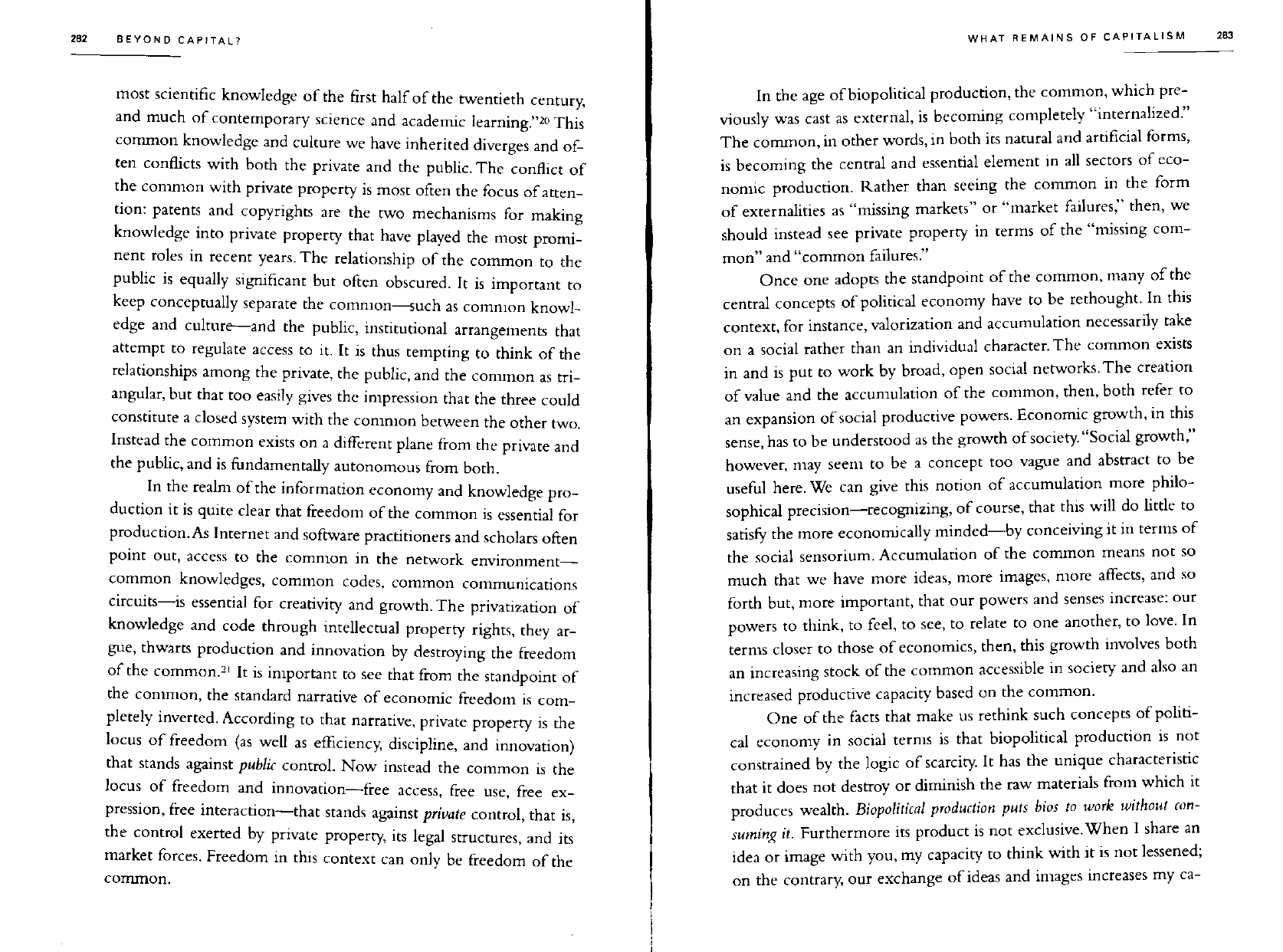
282 BEYOND CAPITAL?
WHAT REMAINS
OF
CAPITALISM
283
most scientific knowledge of the first
half
of the twentieth century,
and much of contemporary science and academic learning."
20
This
common
knowledge and culture we have inherited diverges and of-
ten conflicts
with
both the private and the
public.
The
conflict
of
the common
with
private property is most often the focus of
atten-
tion:
patents
and copyrights are the two mechanisms for making
knowledge into private property
that
have played the most promi-
nent
roles in recent years. The relationship of the common to the
public
is equally significant but often obscured. It is important to
keep conceptually
separate
the common—such as common
knowl-
edge
and culture—and the public, institutional
arrangements
that
attempt
to regulate access to it. It is
thus
tempting to think of the
relationships among the private, the public, and the common as
tri-
angular, but
that
too easily gives the impression
that
the
three
could
constitute a closed system
with
the common between the other two.
Instead the common exists on a different plane from the private and
the public, and is fundamentally autonomous from both.
In
the realm of the information economy and knowledge pro-
duction
it is quite clear
that
freedom of the common is essential for
production.
As
Internet
and software practitioners and scholars often
point out, access to the common in the network environment—
common
knowledges, common codes, common communications
circuits—is
essential for creativity and growth. The privatization of
knowledge and code through intellectual property rights, they ar-
gue, thwarts production and innovation by destroying the freedom
of
the common.
21
It is important to see
that
from the standpoint of
the common, the standard narrative of economic freedom is com-
pletely
inverted.
According
to
that
narrative, private property is the
locus
of freedom (as
well
as efficiency, discipline, and innovation)
that
stands
against public control. Now instead the common is the
locus
of freedom and innovation—free access, free use, free ex-
pression, free interaction—that
stands
against private control,
that
is,
the control exerted by private property, its legal structures, and its
market forces. Freedom in this context can only be freedom of the
common.
In
the age
of
biopolitical
production, the common,
which
pre-
viously
was cast as external, is becoming completely "internalized."
The common, in other words, in both its natural and
artificial
forms,
is
becoming the central and essential element in all sectors of eco-
nomic
production. Rather than seeing the common in the form
of
externalities as "missing markets" or "market failures," then, we
should
instead see private property in
terms
of the "missing com-
mon"
and "common failures."
Once
one
adopts
the standpoint of the common, many of the
central concepts of
political
economy have to be rethought. In this
context, for instance, valorization and accumulation necessarily take
on
a
social
rather
than an
individual
character. The common exists
in
and is put to work by broad, open
social
networks. The creation
of
value and the accumulation of the common, then, both refer to
an expansion of
social
productive powers. Economic growth, in this
sense,
has to be understood as the growth
of
society.
"Social
growth,"
however, may seem to be a concept too vague and
abstract
to be
useful
here. We can give this notion of accumulation more
philo-
sophical
precision—recognizing, of course,
that
this
will
do little to
satisfy
the more economically minded—by conceiving it in
terms
of
the
social
sensorium. Accumulation of the common
means
not so
much
that
we have more ideas, more images, more affects, and so
forth
but, more important,
that
our powers and
senses
increase: our
powers to think, to
feel,
to see, to relate to one another, to love. In
terms
closer to
those
of economics, then, this growth involves both
an increasing stock of the common accessible in society and also an
increased productive capacity based on the common.
One of the facts
that
make us rethink such concepts of
politi-
cal
economy in
social
terms
is
that
biopolitical
production is not
constrained by the
logic
of scarcity. It has the unique characteristic
that
it
does
not destroy or
diminish
the raw materials from
which
it
produces wealth. Biopolitical production
puts
bios
to work
without
con-
suming
it. Furthermore its product is not
exclusive.
When I
share
an
idea
or image
with
you, my capacity to think
with
it is not lessened;
on
the contrary, our exchange of ideas and images increases my ca-
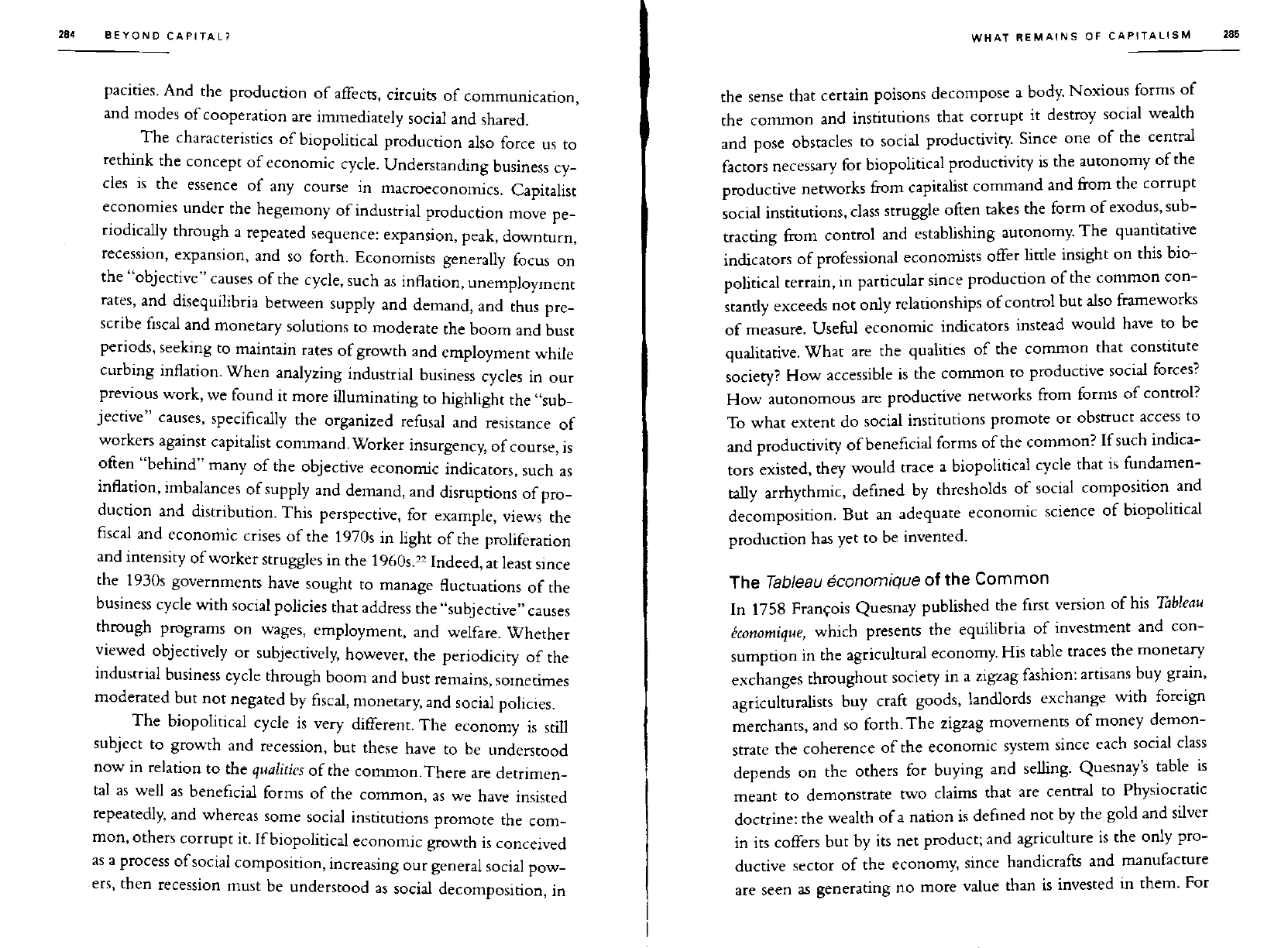
284
BEYOND CAPITAL?
pacifies.
And the production of affects, circuits of communication,
and modes
of
cooperation are immediately social and shared.
The characteristics of
biopolitical
production also force us to
rethink the concept of economic cycle. Understanding business cy-
cles is the
essence
of any course in macroeconomics. Capitalist
economies under the hegemony of industrial production move pe-
riodically
through a
repeated
sequence:
expansion, peak, downturn,
recession, expansion, and so forth. Economists generally focus on
the "objective"
causes
of the cycle, such as inflation, unemployment
rates,
and disequilibria between supply and demand, and
thus
pre-
scribe
fiscal
and monetary solutions to
moderate
the boom and
bust
periods, seeking to maintain
rates
of growth and employment while
curbing
inflation. When analyzing industrial business cycles in our
previous work, we found it more illuminating to highlight the "sub-
jective"
causes,
specifically the organized refusal and resistance of
workers against capitalist command. Worker insurgency, of course, is
often "behind" many of the objective economic indicators, such as
inflation,
imbalances of supply and demand, and disruptions of pro-
duction
and distribution. This perspective, for example, views the
fiscal
and economic crises of the 1970s in light of the proliferation
and intensity
of
worker struggles in the 1960s.
22
Indeed, at least since
the 1930s governments have sought to
manage
fluctuations of the
business cycle with social policies
that
address
the "subjective"
causes
through programs on wages, employment, and welfare. Whether
viewed
objectively or subjectively, however, the periodicity of the
industrial
business cycle through boom and
bust
remains, sometimes
moderated but not
negated
by
fiscal,
monetary, and social policies.
The
biopolitical
cycle is very different. The economy is
still
subject to growth and recession, but
these
have to be understood
now in relation to the qualities of the common. There are detrimen-
tal
as
well
as beneficial forms of the common, as we have insisted
repeatedly, and
whereas
some social institutions promote the com-
mon,
others
corrupt it.
If
biopolitical
economic growth is conceived
as a process
of
social
composition, increasing our general social pow-
ers, then recession must be understood as social decomposition, in
WHAT REMAINS
OF
CAPITALISM
285
the
sense
that
certain poisons decompose a body. Noxious forms of
the common and institutions
that
corrupt it destroy social wealth
and
pose
obstacles to social productivity. Since one of the central
factors necessary for
biopolitical
productivity is the autonomy
of
the
productive networks from capitalist command and from the corrupt
social
institutions, class struggle often
takes
the form of exodus, sub-
tracting from control and establishing autonomy. The quantitative
indicators of professional economists offer little insight on this
bio-
political
terrain, in particular since production of the common con-
stantly exceeds not only relationships of control but also frameworks
of
measure.
Useful
economic indicators instead would have to be
qualitative. What are the qualities of the common
that
constitute
society? How accessible is the common to productive social forces?
How
autonomous are productive networks from forms of control?
To
what
extent
do social institutions promote or obstruct
access
to
and productivity
of
beneficial
forms
of
the common?
If
such indica-
tors
existed, they would
trace
a
biopolitical
cycle
that
is fundamen-
tally
arrhythmic, defined by thresholds of social composition and
decomposition. But an
adequate
economic science of
biopolitical
production has yet to be invented.
The
Tableau
economique
of the Common
In
1758 Francois Quesnay published the first version of his Tableau
economique,
which
presents
the equilibria of investment and con-
sumption in the agricultural economy. His table
traces
the monetary
exchanges throughout society in a zigzag fashion:
artisans
buy grain,
agriculturalists buy craft goods, landlords exchange with foreign
merchants, and so forth. The zigzag movements of money demon-
strate
the coherence of the economic system since each social class
depends
on the
others
for buying and
selling.
Quesnay's table is
meant
to
demonstrate
two claims
that
are central to Physiocratic
doctrine: the wealth
of
a nation is defined not by the gold and silver
in
its coffers but by its net product; and agriculture is the only pro-
ductive sector of the economy, since handicrafts and manufacture
are seen as generating no more value than is invested in them. For
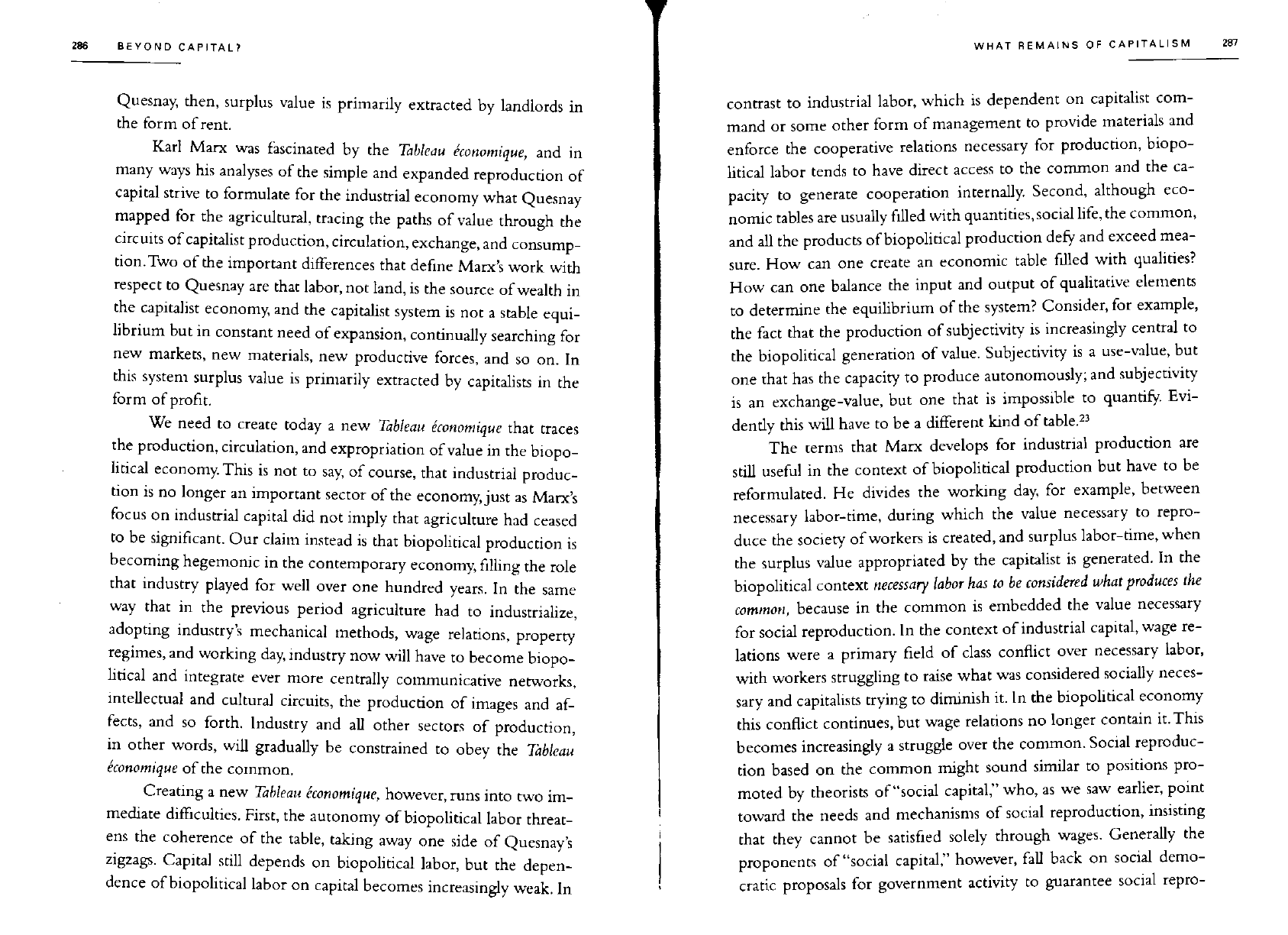
BEYOND CAPITAL?
WHAT REMAINS
OF
CAPITALISM
Quesnay, then, surplus value is primarily extracted by landlords in
the form of
rent.
Karl
Marx
was fascinated by the Tableau
economique,
and in
many ways his analyses of the simple and expanded reproduction of
capital
strive to formulate for the industrial economy what Quesnay
mapped for the agricultural, tracing the
paths
of value through the
circuits
of
capitalist production,
circulation,
exchange, and consump-
tion.
Two
of the important differences
that
define Marx's work with
respect
to Quesnay are
that
labor, not land, is the source
of
wealth in
the capitalist economy, and the capitalist system is not a stable equi-
librium
but in
constant
need of expansion, continually searching for
new markets, new materials, new productive forces, and so on. In
this system surplus value is primarily extracted by capitalists in the
form
of profit.
We
need to
create
today a new Tableau
economique
that
traces
the production,
circulation,
and expropriation
of
value in the biopo-
litical
economy This is not to say, of course,
that
industrial produc-
tion
is no longer an important sector of the economy, just as Marx's
focus on industrial capital did not
imply
that
agriculture had ceased
to be significant. Our
claim
instead is
that
biopolitical
production is
becoming hegemonic in the contemporary economy,
filling
the role
that
industry played for
well
over one hundred years. In the
same
way
that
in the previous period agriculture had to industrialize,
adopting industry's mechanical methods, wage relations, property
regimes, and working day, industry now
will
have to become biopo-
litical
and
integrate
ever more centrally communicative networks,
intellectual
and cultural circuits, the production of images and af-
fects, and so forth. Industry and all other
sectors
of production,
in
other words,
will
gradually be constrained to obey the Tableau
economique
of
the common.
Creating
a new Tableau
economique,
however,
runs
into two im-
mediate difficulties. First, the autonomy of
biopolitical
labor
threat-
ens the coherence of the table, taking away one side of Quesnay s
zigzags.
Capital
still
depends
on
biopolitical
labor, but the depen-
dence
of
biopolitical
labor on capital becomes increasingly weak. In
contrast to industrial labor, which is
dependent
on capitalist com-
mand or some other form of
management
to provide materials and
enforce the cooperative relations necessary for production, biopo-
litical
labor
tends
to have direct
access
to the common and the ca-
pacity to
generate
cooperation internally. Second, although eco-
nomic
tables
are usually
filled
with quantities,
social
life,
the common,
and all the products
of
biopolitical
production defy and exceed mea-
sure. How can one
create
an economic table
filled
with qualities?
How
can one balance the input and
output
of qualitative
elements
to determine the equilibrium of the system? Consider, for example,
the fact
that
the production of subjectivity is increasingly central to
the
biopolitical
generation of value. Subjectivity is a use-value, but
one
that
has the capacity to produce autonomously; and subjectivity
is
an exchange-value, but one
that
is impossible to quantify.
Evi-
dently this
will
have to be a different
kind
of table.
23
The
terms
that
Marx
develops for industrial production are
still
useful in the context of
biopolitical
production but have to be
reformulated. He divides the working day, for example, between
necessary labor-time, during which the value necessary to repro-
duce the society of workers is created, and surplus labor-time, when
the surplus value appropriated by the capitalist is
generated.
In the
biopolitical
context
necessary
labor has to be
considered
what
produces
the
common,
because
in the common is embedded the value necessary
for
social reproduction. In the context
of
industrial
capital, wage re-
lations were a primary
field
of class conflict over necessary labor,
with
workers struggling to raise what was considered socially neces-
sary and capitalists trying to diminish it. In the
biopolitical
economy
this conflict continues, but wage relations no longer contain
it.
This
becomes increasingly a struggle over the common.
Social
reproduc-
tion
based on the common might sound similar to positions pro-
moted by theorists of
"social
capital," who, as we saw earlier, point
toward the
needs
and mechanisms of social reproduction, insisting
that
they cannot be satisfied solely through wages. Generally the
proponents of
"social
capital," however,
fall
back on social demo-
cratic proposals for government activity to
guarantee
social repro-
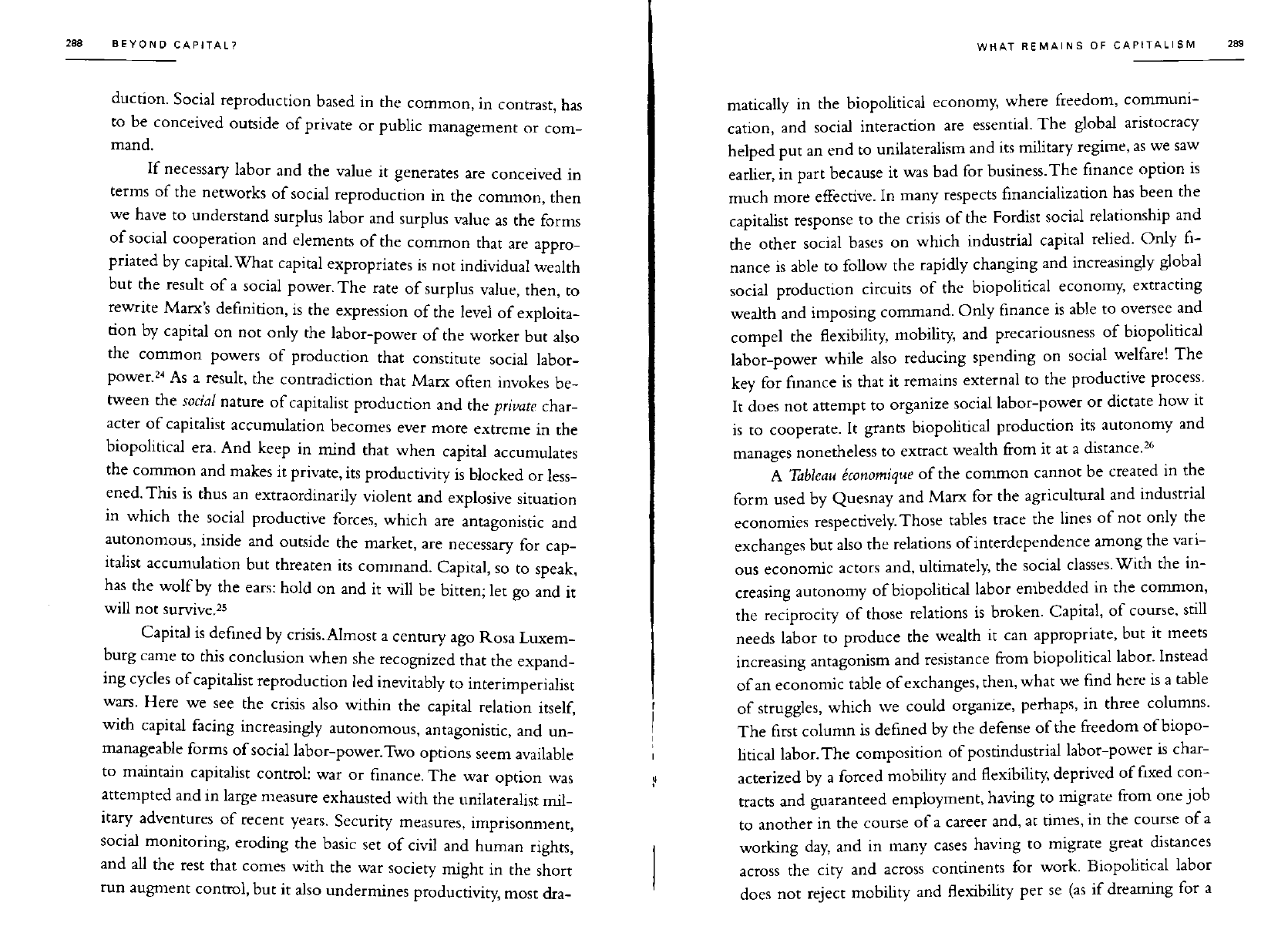
288
BEYOND CAPITAL? WHAT REMAINS
OF
CAPITALISM
289
duction.
Social
reproduction based in the common, in contrast, has
to be conceived outside of private or public
management
or com-
mand.
If
necessary labor and the value it
generates
are conceived in
terms
of the networks of social reproduction in the common, then
we have to understand surplus labor and surplus value as the forms
of
social cooperation and
elements
of the common
that
are appro-
priated by
capital.
What capital expropriates is not
individual
wealth
but the result of a social power. The
rate
of surplus value, then, to
rewrite Marx's definition, is the expression of the
level
of exploita-
tion
by capital on not only the labor-power of the worker but also
the common powers of production
that
constitute social labor-
power.
24
As a result, the contradiction
that
Marx
often invokes be-
tween the social
nature
of capitalist production and the private char-
acter
of capitalist accumulation becomes ever more extreme in the
biopolitical
era. And keep in mind
that
when capital accumulates
the common and makes it private, its productivity is blocked or less-
ened. This is
thus
an extraordinarily violent and explosive situation
in
which the social productive forces, which are antagonistic and
autonomous, inside and outside the market, are necessary for cap-
italist
accumulation but
threaten
its command.
Capital,
so to
speak,
has the
wolf
by the
ears:
hold on and it
will
be bitten; let go and it
will
not survive.
25
Capital
is defined by
crisis.
Almost
a century ago Rosa
Luxem-
burg came to this conclusion when she recognized
that
the expand-
ing
cycles of capitalist reproduction led inevitably to interimperialist
wars. Here we see the crisis also
within
the capital relation itself,
with
capital facing increasingly autonomous, antagonistic, and un-
manageable forms of
social
labor-power.
Two
options seem available
to maintain capitalist control: war or finance. The war option was
attempted
and in large
measure
exhausted with the unilateralist
mil-
itary
adventures
of
recent
years. Security
measures,
imprisonment,
social
monitoring, eroding the basic set of
civil
and human rights,
and all the
rest
that
comes with the war society might in the short
run
augment
control, but it also undermines productivity, most dra-
matically
in the
biopolitical
economy, where freedom, communi-
cation,
and social interaction are essential. The global aristocracy
helped put an end to unilateralism and its military regime, as we saw
earlier, in
part
because
it was bad for business. The finance option is
much
more effective. In many
respects
financialization has been the
capitalist
response
to the crisis of the Fordist social relationship and
the other social
bases
on which industrial capital relied.
Only
fi-
nance
is able to
follow
the rapidly changing and increasingly global
social
production circuits of the
biopolitical
economy, extracting
wealth and imposing command.
Only
finance is able to oversee and
compel
the
flexibility,
mobility, and precariousness of
biopolitical
labor-power while also reducing spending on social welfare! The
key
for finance is
that
it remains external to the productive process.
It
does
not
attempt
to organize social labor-power or dictate how it
is
to cooperate. It
grants
biopolitical
production its autonomy and
manages
nonetheless
to extract wealth from it at a distance.
26
A
Tableau
economique
of the common cannot be created in the
form
used by Quesnay and
Marx
for the agricultural and industrial
economies respectively. Those
tables
trace
the lines of not only the
exchanges but also the relations
of
interdependence among the
vari-
ous economic
actors
and, ultimately, the social classes.
With
the in-
creasing autonomy of
biopolitical
labor embedded in the common,
the reciprocity of
those
relations is broken.
Capital,
of course,
still
needs
labor to produce the wealth it can appropriate, but it
meets
increasing antagonism and resistance from
biopolitical
labor. Instead
of
an economic table
of
exchanges, then, what we
find
here
is a table
of
struggles, which we could organize,
perhaps,
in
three
columns.
The first column is defined by the
defense
of
the freedom
of
biopo-
litical
labor. The composition of postindustrial labor-power is char-
acterized by a forced mobility and
flexibility,
deprived of
fixed
con-
tracts
and
guaranteed
employment, having to migrate from one job
to
another
in the course of a career and, at times, in the course of a
working
day, and in many
cases
having to migrate
great
distances
across the city and across continents for work.
Biopolitical
labor
does
not reject mobility and
flexibility
per se (as if dreaming for a
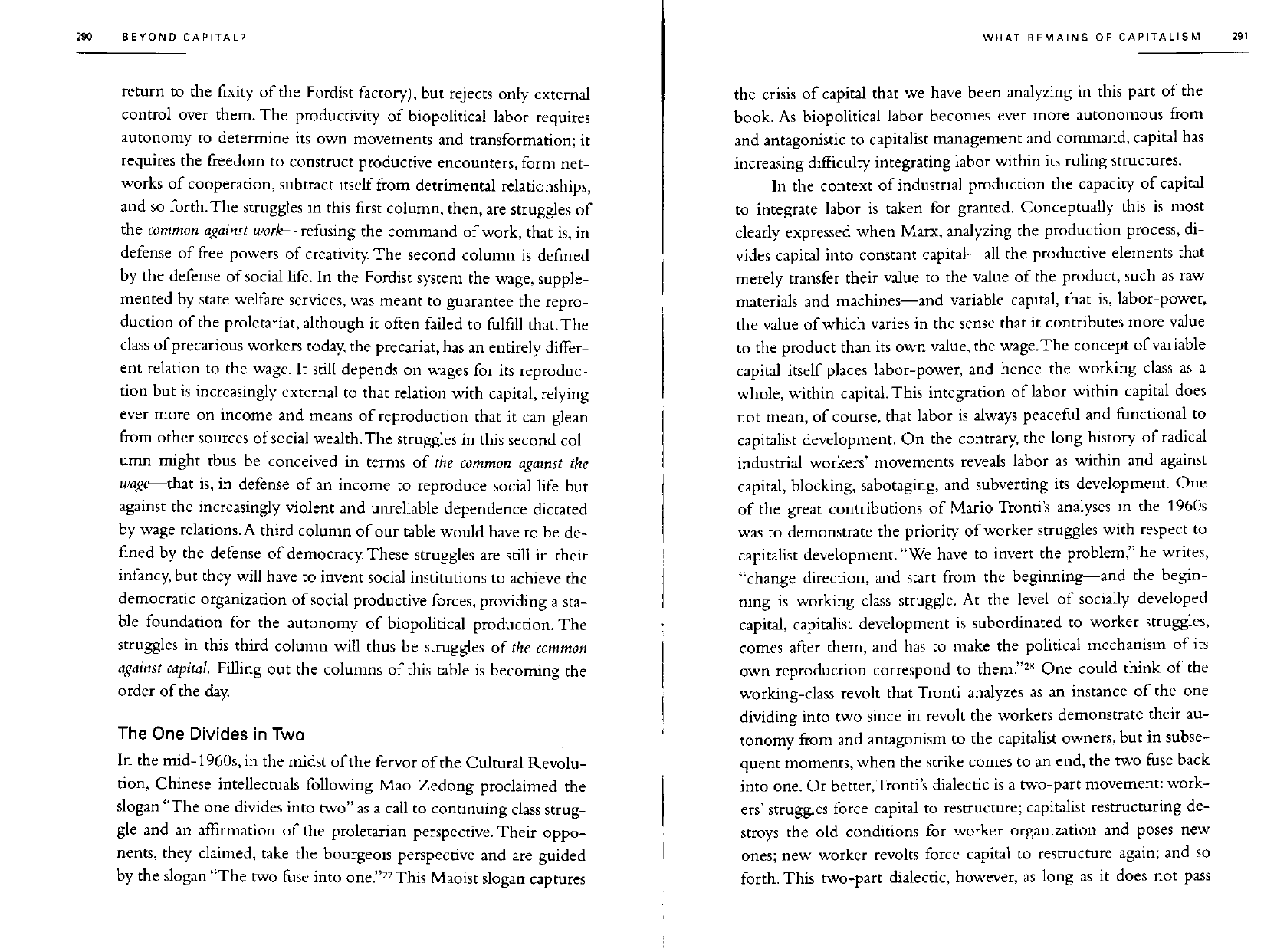
290
BEYOND CAPITAL?
WHAT REMAINS
OF
CAPITALISM
291
return to the
fixity
of the Fordist factory), but
rejects
only external
control
over them. The productivity of
biopolitical
labor requires
autonomy to determine its own movements and transformation; it
requires the freedom to construct productive encounters, form
net-
works of cooperation,
subtract
itself
from detrimental relationships,
and so forth.The struggles in this first column, then, are struggles of
the
common
against
work—refusing the command of work,
that
is, in
defense
of free powers of creativity. The second column is defined
by
the
defense
of
social
life.
In the Fordist system the wage, supple-
mented by
state
welfare services, was
meant
to
guarantee
the repro-
duction
of the proletariat, although it often
failed
to
fulfill
that.
The
class
of
precarious workers today, the precariat, has an entirely differ-
ent relation to the wage. It
still
depends
on
wages
for its reproduc-
tion
but is increasingly external to
that
relation with capital, relying
ever more on income and
means
of reproduction
that
it can glean
from
other sources
of
social
wealth. The struggles in this second
col-
umn might
thus
be conceived in
terms
of the
common
against
the
wage—that
is, in
defense
of an income to reproduce social
life
but
against the increasingly violent and unreliable
dependence
dictated
by
wage relations. A third column of our table would have to be de-
fined
by
the
defense
of democracy. These struggles are
still
in their
infancy,
but they
will
have to invent social institutions to achieve the
democratic organization of
social
productive forces, providing a sta-
ble foundation for the autonomy of
biopolitical
production. The
struggles in this third column
will
thus
be struggles of the
common
against
capital.
Filling
out the columns of this table is becoming the
order of the day.
The One
Divides
in Two
In
the mid-1960s, in the midst of the fervor
of
the Cultural
Revolu-
tion,
Chinese intellectuals
following
Mao Zedong proclaimed the
slogan "The one divides into two" as a
call
to continuing class strug-
gle and an affirmation of the proletarian perspective. Their oppo-
nents,
they claimed,
take
the bourgeois perspective and are guided
by
the slogan "The two fuse into one."
27
This Maoist slogan
captures
the crisis of capital
that
we have been analyzing in this
part
of the
book. As
biopolitical
labor becomes ever more autonomous from
and antagonistic to capitalist
management
and command, capital has
increasing
difficulty
integrating labor
within
its ruling structures.
In
the context of industrial production the capacity of capital
to
integrate
labor is taken for granted. Conceptually this is most
clearly
expressed when
Marx,
analyzing the production process, di-
vides capital into
constant
capital—all the productive
elements
that
merely transfer their value to the value of the product, such as raw
materials and machines—and variable capital,
that
is, labor-power,
the value of which varies in the
sense
that
it contributes more value
to the product than its own value, the wage. The concept
of
variable
capital
itself
places labor-power, and
hence
the working class as a
whole,
within
capital. This integration of labor
within
capital
does
not mean, of course,
that
labor is always peaceful and functional to
capitalist development. On the contrary, the long history of radical
industrial
workers' movements reveals labor as
within
and against
capital,
blocking, sabotaging, and subverting its development. One
of
the
great
contributions of
Mario
Tronti's analyses in the 1960s
was to
demonstrate
the priority of worker struggles with
respect
to
capitalist development. "We have to invert the problem," he writes,
"change
direction, and
start
from the beginning—and the begin-
ning
is working-class struggle. At the
level
of socially developed
capital,
capitalist development is subordinated to worker struggles,
comes after them, and has to make the
political
mechanism of its
own
reproduction correspond to them."
28
One could think of the
working-class
revolt
that
Tronti analyzes as an instance of the one
dividing
into two since in revolt the workers
demonstrate
their au-
tonomy from and antagonism to the capitalist owners, but in
subse-
quent
moments, when the strike comes to an end, the two fuse back
into one. Or better,Tronti's dialectic is a two-part movement: work-
ers' struggles force capital to restructure; capitalist restructuring de-
stroys the old conditions for worker organization and
poses
new
ones; new worker revolts force capital to
restructure
again; and so
forth.
This two-part dialectic, however, as long as it
does
not
pass
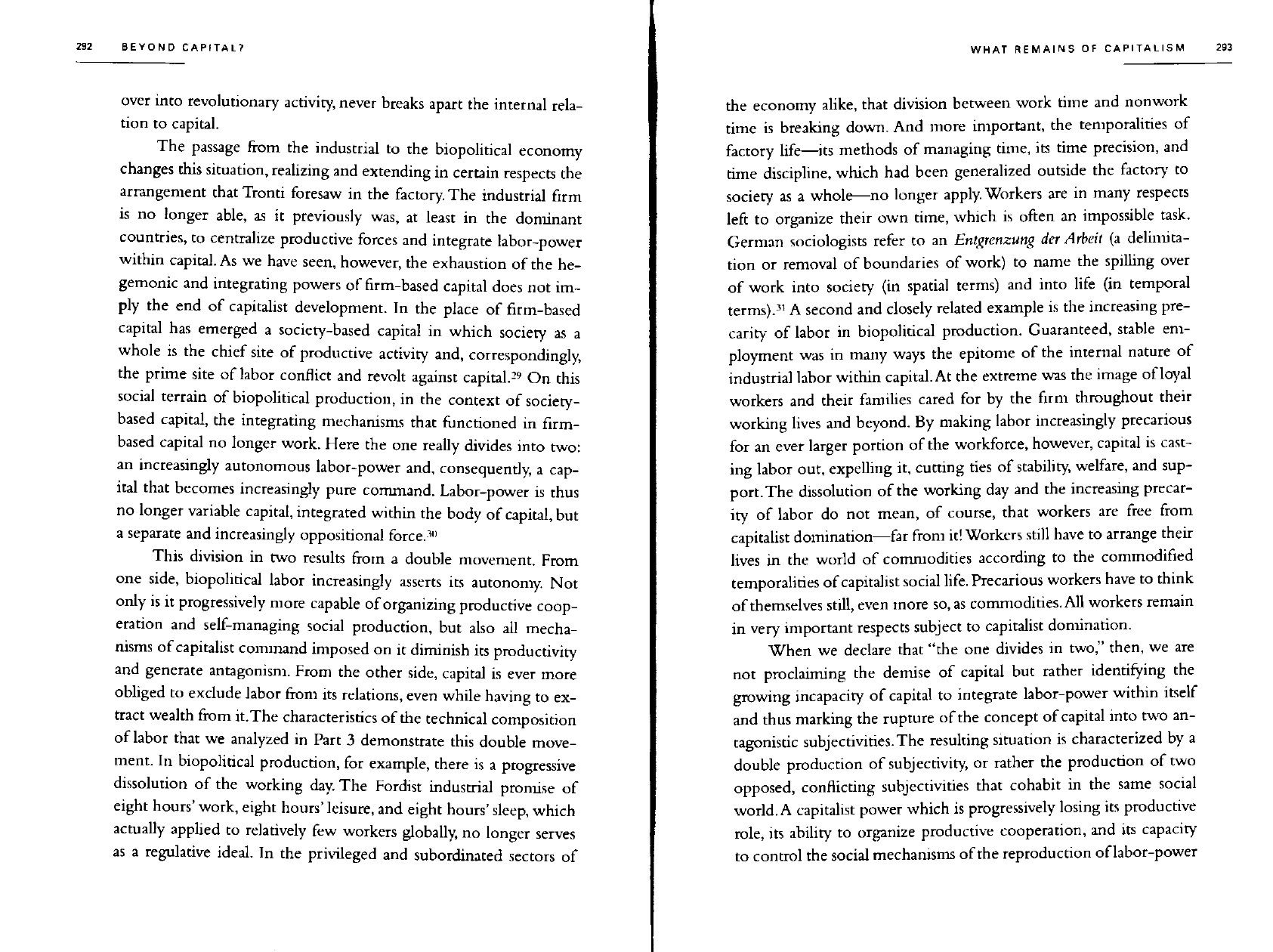
BEYOND CAPITAL?
WHAT REMAINS
OF
CAPITALISM
over into revolutionary activity, never breaks
apart
the internal rela-
tion
to capital.
The
passage
from the industrial to the
biopolitical
economy
changes
this situation, realizing and extending in certain
respects
the
arrangement
that
Tronti foresaw in the factory. The industrial
firm
is
no longer able, as it previously was, at least in the dominant
countries, to centralize productive forces and
integrate
labor-power
within
capital. As we have seen, however, the exhaustion of the he-
gemonic and integrating powers of firm-based capital
does
not im-
ply
the end of capitalist development. In the place of firm-based
capital
has emerged a society-based capital in which society as a
whole is the
chief
site of productive activity and, correspondingly,
the prime site of labor conflict and revolt against capital.
29
On this
social
terrain of
biopolitical
production, in the context of society-
based capital, the integrating mechanisms
that
functioned in
firm-
based capital no longer work. Here the one really divides into two:
an increasingly autonomous labor-power and, consequently, a cap-
ital
that
becomes increasingly
pure
command. Labor-power is
thus
no longer variable capital, integrated
within
the body of capital, but
a
separate
and increasingly oppositional force.
30
This
division
in two results from a double movement. From
one side,
biopolitical
labor increasingly
asserts
its autonomy. Not
only
is it progressively more capable of organizing productive coop-
eration and self-managing social production, but also all mecha-
nisms of capitalist command imposed on it diminish its productivity
and
generate
antagonism. From the other side, capital is ever more
obliged
to exclude labor from its relations, even while having to ex-
tract
wealth from
it.
The characteristics of the technical composition
of
labor
that
we analyzed in Part 3
demonstrate
this double move-
ment.
In
biopolitical
production, for example,
there
is a progressive
dissolution
of the working day. The Fordist industrial promise of
eight hours' work, eight hours' leisure, and eight hours' sleep, which
actually
applied to relatively few workers globally, no longer
serves
as a regulative ideal. In the privileged and subordinated
sectors
of
the economy alike,
that
division
between work time and nonwork
time is breaking down. And more important, the temporalities of
factory life—its
methods
of managing time, its time precision, and
time discipline, which had been generalized outside the factory to
society as a whole—no longer apply. Workers are in many
respects
left
to organize their own time, which is often an impossible
task.
German
sociologists refer to an Entgrenzung der Arbeit (a delimita-
tion
or removal of boundaries of work) to
name
the
spilling
over
of
work into society (in spatial
terms)
and into
life
(in temporal
terms).
31
A second and closely related example is the increasing pre-
carity
of labor in
biopolitical
production. Guaranteed, stable em-
ployment was in many ways the epitome of the internal
nature
of
industrial
labor
within
capital.
At the extreme was the image
of
loyal
workers and their families cared for by the
firm
throughout their
working
lives and beyond. By making labor increasingly precarious
for
an ever larger portion of the workforce, however, capital is
cast-
ing
labor out, expelling it, cutting ties of stability, welfare, and sup-
port. The dissolution of the working day and the increasing precar-
ity
of labor do not mean, of course,
that
workers are free from
capitalist domination—far from
it!
Workers
still
have to
arrange
their
lives
in the
world
of commodities according to the commodified
temporalities
of
capitalist social
life.
Precarious workers have to think
of
themselves
still,
even more so, as commodities.
All
workers remain
in
very important
respects
subject to capitalist domination.
When
we declare
that
"the one divides in two," then, we are
not proclaiming the demise of capital but
rather
identifying the
growing
incapacity of capital to
integrate
labor-power
within
itself
and
thus
marking the
rupture
of the concept of capital into two an-
tagonistic subjectivities. The resulting situation is characterized by a
double production of subjectivity, or
rather
the production of two
opposed, conflicting subjectivities
that
cohabit in the
same
social
world.
A capitalist power which is progressively losing its productive
role,
its ability to organize productive cooperation, and its capacity
to control the social mechanisms
of
the reproduction
of
labor-power
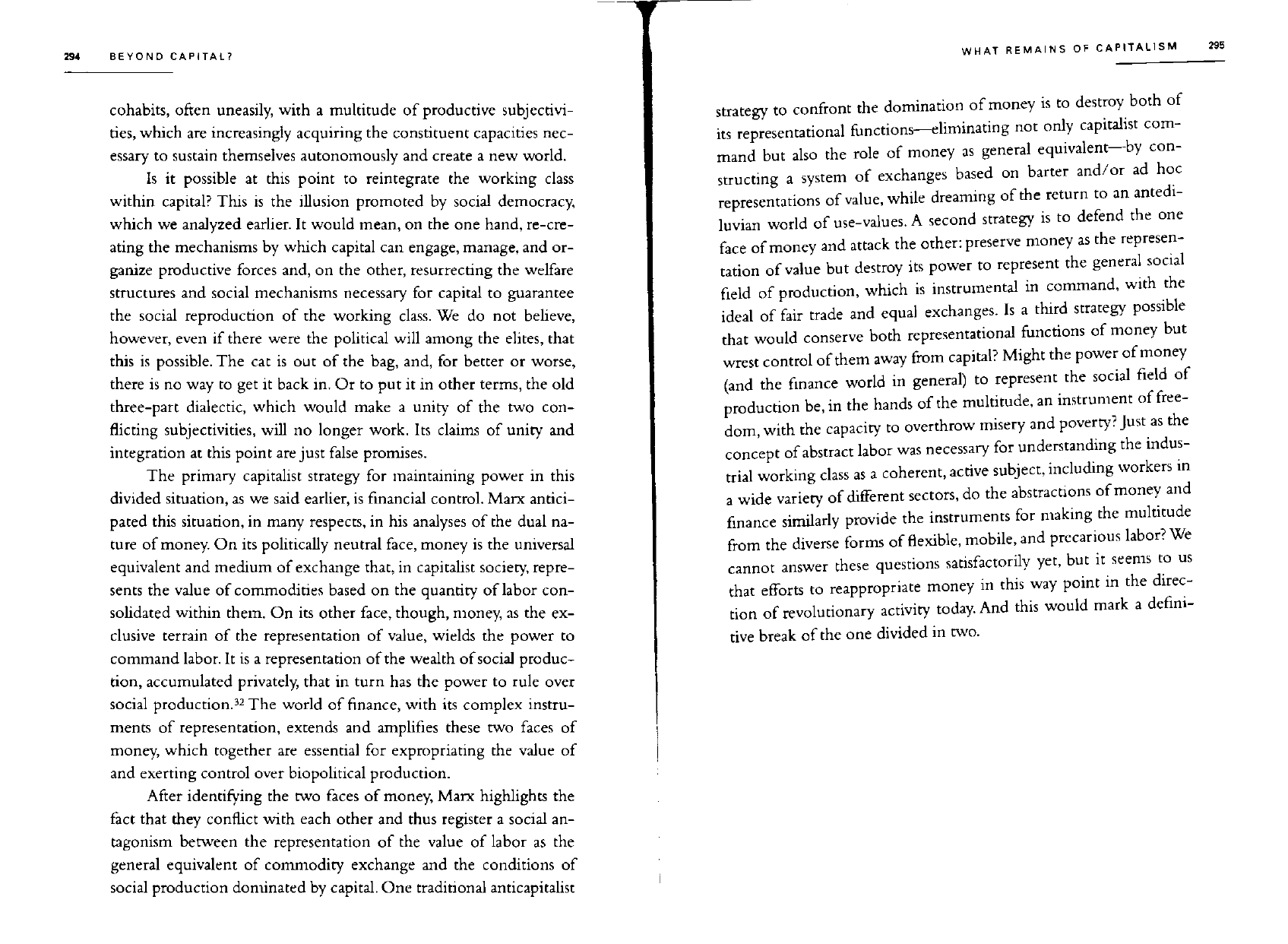
294
BEYOND CAPITAL?
WHAT REMAINS
OF
CAPITALISM
295
cohabits, often uneasily,
with
a multitude of productive subjectivi-
ties,
which
are increasingly acquiring the constituent capacities nec-
essary to sustain themselves autonomously and
create
a new
world.
Is it possible at this point to reintegrate the working class
within
capital? This is the
illusion
promoted by
social
democracy,
which
we analyzed earlier. It
would
mean, on the one hand, re-cre-
ating the mechanisms by
which
capital can
engage,
manage, and or-
ganize productive forces and, on the other, resurrecting the welfare
structures and
social
mechanisms necessary for capital to
guarantee
the
social
reproduction of the working class. We do not believe,
however, even if
there
were the
political
will
among the elites,
that
this is possible. The cat is out of the bag, and, for
better
or worse,
there
is no way to get it back in. Or to put it in other terms, the old
three-part
dialectic,
which
would
make a unity of the two con-
flicting
subjectivities,
will
no longer work. Its claims of unity and
integration at this point are just false promises.
The primary capitalist strategy for maintaining power in this
divided
situation, as we said earlier, is
financial
control.
Marx
antici-
pated this situation, in many respects, in his analyses of the dual na-
ture
of money. On its
politically
neutral face, money is the universal
equivalent and medium of exchange
that,
in capitalist society, repre-
sents
the value of commodities based on the quantity of labor con-
solidated
within
them. On its other face, though, money, as the ex-
clusive
terrain of the representation of value, wields the power to
command labor. It is a representation of the wealth
of
social
produc-
tion,
accumulated privately,
that
in turn has the power to rule over
social
production.
32
The
world
of finance,
with
its complex instru-
ments
of representation, extends and amplifies
these
two faces of
money,
which
together
are essential for expropriating the value of
and exerting control over
biopolitical
production.
After
identifying the two faces of money,
Marx
highlights the
fact
that
they
conflict
with
each other and
thus
register a
social
an-
tagonism between the representation of the value of labor as the
general equivalent of commodity exchange and the conditions of
social
production dominated by capital. One traditional anticapitalist
strategy to confront the domination of money is to destroy both of
its representational functions—eliminating not only capitalist com-
mand but also the role of money as general equivalent—by con-
structing a system of exchanges based on barter and/or ad hoc
representations of
value,
while dreaming of the return to an antedi-
luvian
world
of use-values. A second strategy is to defend the one
face of money and attack the other: preserve money as the represen-
tation of value but destroy its power to
represent
the general
social
field
of production,
which
is instrumental in command,
with
the
ideal
of
fair
trade
and equal exchanges. Is a third strategy possible
that
would
conserve both representational functions of money but
wrest control
of
them away from capital?
Might
the power
of
money
(and the finance
world
in general) to
represent
the
social
field
of
production
be, in the
hands
of the multitude, an instrument of free-
dom,
with
the capacity to overthrow misery and poverty? Just as the
concept
of
abstract
labor was necessary for understanding the indus-
trial
working class as a coherent, active subject,
including
workers in
a
wide variety of different sectors, do the abstractions
of
money and
finance
similarly
provide the instruments for making the multitude
from
the diverse forms of
flexible,
mobile, and precarious labor? We
cannot answer
these
questions satisfactorily yet, but it
seems
to us
that
efforts to reappropriate money in this way point in the direc-
tion
of revolutionary activity today. And this
would
mark a
defini-
tive
break of the one
divided
in two.
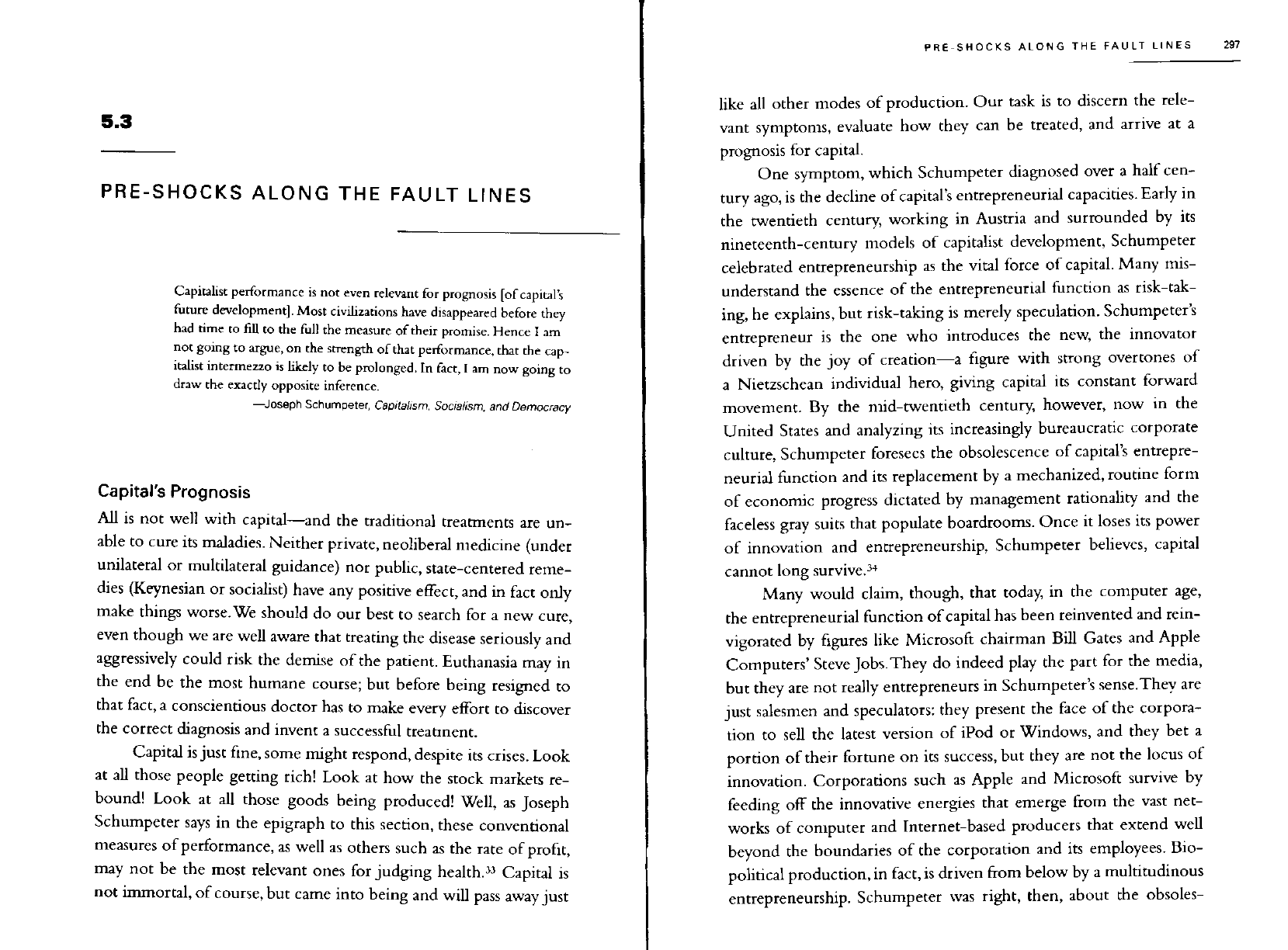
PRE-SHOCKS ALONG
THE
FAULT LINES
297
5.3
PRE-SHOCKS
ALONG
THE
FAULT
LINES
Capitalist
performance is not even relevant for prognosis [of capital's
future development].
Most
civilizations
have disappeared before they
had time to
fill
to the
full
the measure of their promise. Hence I am
not going to argue, on the strength of
that
performance,
that
the cap-
italist
intermezzo is
likely
to be prolonged. In fact, I am now going to
draw the exactly opposite inference.
—Joseph
Schumpeter,
Capitalism,
Socialism,
and
Democracy
Capital's
Prognosis
All
is not
well
with
capital—and the traditional
treatments
are un-
able to cure its maladies. Neither private, neoliberal medicine (under
unilateral
or multilateral guidance) nor
public,
state-centered reme-
dies (Keynesian or socialist) have any positive effect, and in fact
only
make things worse. We should do our
best
to search for a new cure,
even though we are
well
aware
that
treating the disease seriously and
aggressively
could
risk
the demise of the patient. Euthanasia may in
the end be the most humane course; but before being resigned to
that
fact, a conscientious doctor has to make every effort to discover
the correct diagnosis and invent a successful
treatment.
Capital
is
just
fine,
some might respond, despite its crises.
Look
at all those people getting
rich!
Look
at how the stock markets re-
bound!
Look
at all those goods being produced!
Well,
as Joseph
Schumpeter says in the epigraph to this section,
these
conventional
measures of performance, as
well
as others such as the
rate
of profit,
may
not be the most relevant ones for judging health.
33
Capital
is
not immortal, of course, but came into being and
will
pass
away just
like
all other modes of production. Our task is to discern the rele-
vant symptoms, evaluate how they can be treated, and arrive at a
prognosis for capital.
One
symptom,
which
Schumpeter diagnosed over a
half
cen-
tury ago, is the decline of capital's entrepreneurial capacities.
Early
in
the twentieth century,
working
in
Austria
and surrounded by its
nineteenth-century models of capitalist development, Schumpeter
celebrated entrepreneurship as the
vital
force of
capital.
Many
mis-
understand the essence of the entrepreneurial function as risk-tak-
ing,
he explains, but risk-taking is merely speculation. Schumpeter's
entrepreneur is the one who introduces the new, the innovator
driven
by the joy of creation—a figure
with
strong overtones of
a
Nietzschean
individual
hero,
giving
capital its constant forward
movement. By the mid-twentieth century, however, now in the
United
States
and analyzing its increasingly bureaucratic corporate
culture,
Schumpeter foresees the obsolescence of capital's entrepre-
neurial
function and its replacement by a mechanized, routine
form
of
economic progress dictated by management rationality and the
faceless gray suits
that
populate boardrooms. Once it loses its power
of
innovation and entrepreneurship, Schumpeter believes, capital
cannot
long
survive.
34
Many
would
claim,
though,
that
today, in the computer age,
the entrepreneurial function of
capital
has been reinvented and rein-
vigorated
by figures
like
Microsoft
chairman
Bill
Gates and
Apple
Computers'
Steve Jobs. They do indeed play the part for the media,
but they are not really entrepreneurs in Schumpeter's sense.
They
are
just salesmen and speculators: they present the face of the corpora-
tion
to
sell
the latest version of
iPod
or
Windows,
and they bet a
portion
of their fortune on its success, but they are not the locus of
innovation.
Corporations such as
Apple
and
Microsoft
survive by
feeding
off the innovative energies
that
emerge
from
the vast
net-
works
of computer and Internet-based producers
that
extend
well
beyond
the boundaries of the corporation and its employees.
Bio-
political
production, in fact, is driven
from
below by a multitudinous
entrepreneurship. Schumpeter was right, then, about the obsoles-
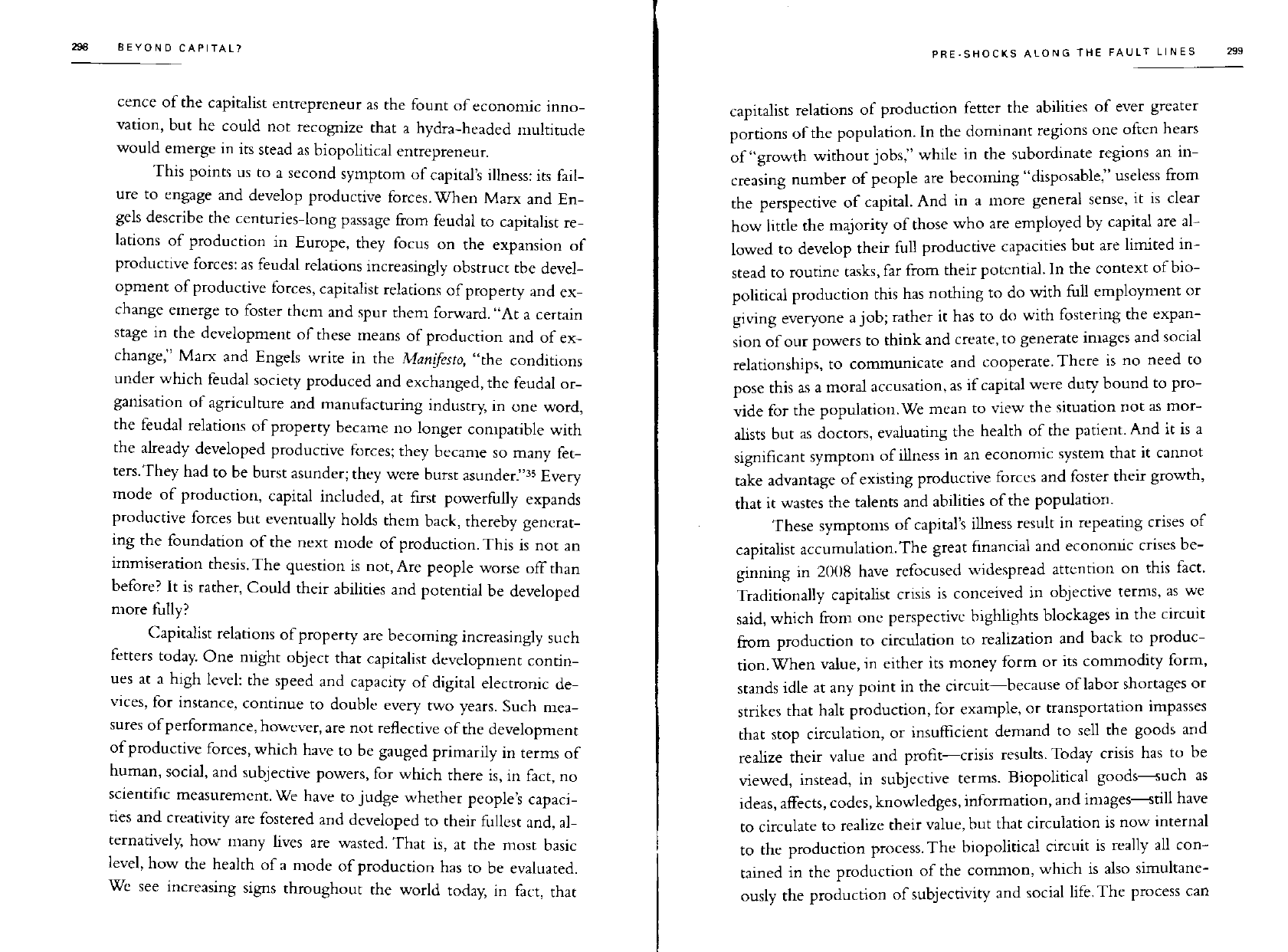
298 BEYOND CAPITAL?
cence of the capitalist entrepreneur as the fount of economic inno-
vation,
but he
could
not recognize
that
a hydra-headed multitude
would
emerge in its stead as
biopolitical
entrepreneur.
This
points us to a second symptom of capital's illness: its
fail-
ure to
engage
and develop productive forces. When
Marx
and En-
gels describe the centuries-long
passage
from feudal to capitalist re-
lations of production in Europe, they focus on the expansion of
productive forces: as feudal relations increasingly obstruct the devel-
opment of productive forces, capitalist relations of property and ex-
change emerge to foster them and spur them forward. "At a certain
stage
in the development of
these
means
of production and of ex-
change,"
Marx
and Engels write in the Manifesto, "the conditions
under
which
feudal society produced and exchanged, the feudal or-
ganisation of agriculture and manufacturing industry, in one word,
the feudal relations of property became no longer compatible
with
the already developed productive forces; they became so many fet-
ters.They had to be burst asunder; they were burst asunder."
35
Every
mode of production, capital included, at first powerfully expands
productive forces but eventually holds them back, thereby
generat-
ing
the foundation of the next mode of production. This is not an
immiseration
thesis. The question is not, Are people worse off than
before? It is
rather,
Could
their abilities and potential be developed
more
fully?
Capitalist
relations of property are becoming increasingly such
fetters
today. One might object
that
capitalist development contin-
ues at a high
level:
the speed and capacity of
digital
electronic de-
vices,
for instance, continue to double every two years. Such mea-
sures
of
performance, however, are not reflective
of
the development
of
productive forces,
which
have to be gauged primarily in
terms
of
human,
social,
and subjective powers, for
which
there
is, in fact, no
scientific
measurement. We have to judge whether people's capaci-
ties and creativity are fostered and developed to their fullest and, al-
ternatively, how many lives are wasted. That is, at the most basic
level,
how the health of a mode of production has to be evaluated.
We
see increasing signs throughout the
world
today, in fact,
that
PRE-SHOCKS ALONG
THE
FAULT LINES
299
capitalist
relations of production fetter the abilities of ever
greater
portions of the population. In the dominant regions one often
hears
of
"growth without jobs," while in the subordinate regions an in-
creasing number of people are becoming "disposable," useless from
the perspective of capital. And in a more general
sense,
it is clear
how
little the majority of
those
who are employed by capital are al-
lowed
to develop their
full
productive capacities but are
limited
in-
stead to routine tasks, far from their potential. In the context of
bio-
political
production this has nothing to do
with
full
employment or
giving
everyone a job;
rather
it has to do
with
fostering the expan-
sion
of
our powers to think and create, to
generate
images and
social
relationships, to communicate and cooperate. There is no need to
pose this as a moral accusation, as if capital were duty bound to pro-
vide
for the population. We mean to
view
the situation not as mor-
alists but as doctors, evaluating the health of the patient. And it is a
significant
symptom of
illness
in an economic system
that
it cannot
take
advantage
of existing productive forces and foster their growth,
that
it
wastes
the
talents
and abilities of the population.
These symptoms of capital's illness result in repeating crises of
capitalist
accumulation.The
great
financial
and economic crises be-
ginning
in 2008 have refocused widespread attention on this fact.
Traditionally
capitalist crisis is conceived in objective terms, as we
said,
which
from one perspective highlights blockages in the circuit
from
production to circulation to realization and back to produc-
tion.
When value, in either its money form or its commodity form,
stands
idle at any point in the circuit—because
of
labor
shortages
or
strikes
that
halt production, for example, or transportation impasses
that
stop circulation, or insufficient demand to
sell
the goods and
realize
their value and profit—crisis results. Today crisis has to be
viewed,
instead, in subjective terms.
Biopolitical
goods—such as
ideas, affects, codes, knowledges, information, and images—still have
to circulate to realize their value, but
that
circulation is now internal
to the production process. The
biopolitical
circuit is really all con-
tained in the production of the common,
which
is also simultane-
ously
the production of subjectivity and
social
life.
The process can
•
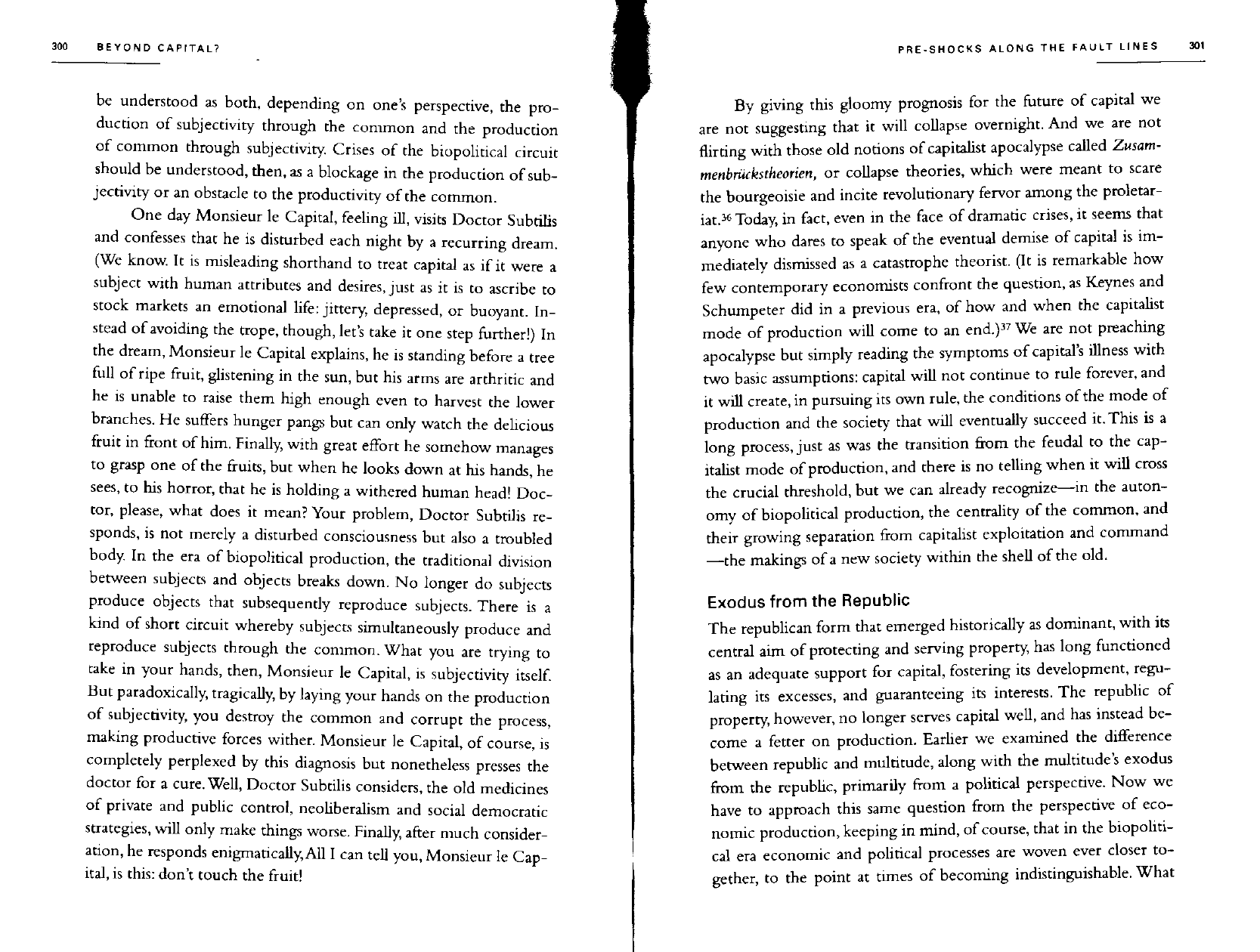
300
BEYOND CAPITAL?
PRE-SHOCKS ALONG
THE
FAULT LINES
301
be understood as both, depending on
one's
perspective, the pro-
duction
of subjectivity through the common and the production
of
common through subjectivity. Crises of the
biopolitical
circuit
should
be understood, then, as a blockage in the production of sub-
jectivity
or an obstacle to the productivity
of
the common.
One
day Monsieur le
Capital,
feeling
ill,
visits Doctor
Subtilis
and confesses
that
he is disturbed each night by a recurring dream.
(We
know. It is misleading shorthand to
treat
capital as if it were a
subject
with
human attributes and desires, just as it is to ascribe to
stock markets an emotional
life:
jittery, depressed, or buoyant. In-
stead of
avoiding
the trope, though, let's take it one
step
further!) In
the dream, Monsieur le
Capital
explains, he is standing before a
tree
full
of ripe fruit, glistening in the sun, but his arms are arthritic and
he is unable to raise them high enough even to harvest the lower
branches. He suffers hunger
pangs
but can
only
watch the delicious
fruit
in front of
him.
Finally,
with
great
effort he somehow
manages
to grasp one of the fruits, but when he looks down at his hands, he
sees,
to his horror,
that
he is holding a withered human head!
Doc-
tor, please, what
does
it mean?
Your
problem, Doctor
Subtilis
re-
sponds, is not merely a disturbed consciousness but also a troubled
body.
In the era of
biopolitical
production, the traditional
division
between subjects and objects breaks down. No longer do subjects
produce objects
that
subsequently reproduce subjects. There is a
kind
of short
circuit
whereby subjects simultaneously produce and
reproduce subjects through the common. What you are trying to
take in your hands, then, Monsieur le
Capital,
is subjectivity itself.
But
paradoxically,
tragically,
by
laying
your
hands
on the production
of
subjectivity, you destroy the common and corrupt the process,
making
productive forces wither. Monsieur le
Capital,
of course, is
completely
perplexed by this diagnosis but nonetheless
presses
the
doctor for a cure.
Well,
Doctor
Subtilis
considers, the old medicines
of
private and public control, neoliberalism and
social
democratic
strategies,
will
only
make things worse.
Finally,
after much consider-
ation,
he responds
enigmatically,
All
I can
tell
you, Monsieur le
Cap-
ital,
is this: don't touch the fruit!
By
giving
this gloomy prognosis for the future of capital we
are not suggesting
that
it
will
collapse overnight. And we are not
flirting
with
those
old notions of capitalist apocalypse
called
Zusam-
menbriickstheorien, or collapse theories,
which
were
meant
to scare
the bourgeoisie and incite revolutionary fervor among the proletar-
iat.
36
Today, in fact, even in the face of dramatic crises, it
seems
that
anyone who
dares
to speak of the eventual demise of capital is im-
mediately
dismissed as a
catastrophe
theorist. (It is remarkable how
few
contemporary economists confront the question, as Keynes and
Schumpeter did in a previous era, of how and when the capitalist
mode of production
will
come to an end.)
37
We are not preaching
apocalypse but
simply
reading the symptoms of capital's illness
with
two
basic assumptions: capital
will
not continue to rule forever, and
it will
create, in pursuing its own rule, the conditions
of
the mode of
production
and the society
that
will
eventually succeed
it.
This
is a
long
process, just as was the transition
from
the feudal to the cap-
italist
mode of
production,
and
there
is no
telling
when it
will
cross
the
crucial
threshold, but we can already recognize—in the auton-
omy
of
biopolitical
production, the centrality of the common, and
their growing separation
from
capitalist exploitation and command
—the
makings
of a
new society
within
the
shell
of
the old.
Exodus
from
the
Republic
The
republican
form
that
emerged
historically
as dominant,
with
its
central
aim of protecting and serving property, has
long
functioned
as an
adequate
support for capital, fostering its development, regu-
lating
its excesses, and guaranteeing its interests. The republic of
property, however, no longer serves capital
well,
and has instead be-
come a fetter on production.
Earlier
we examined the difference
between republic and multitude, along
with
the multitude's exodus
from
the republic,
primarily
from
a
political
perspective. Now we
have to approach this
same
question
from
the perspective of eco-
nomic
production, keeping in
mind,
of course,
that
in the
biopoliti-
cal
era economic and
political
processes are woven ever closer to-
gether,
to the point at times of becoming
indistinguishable.
What
